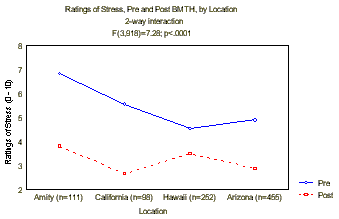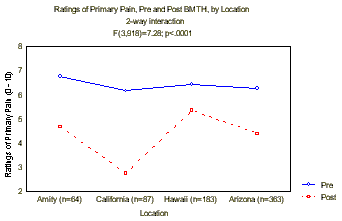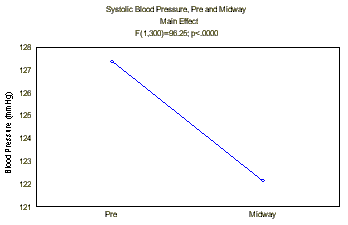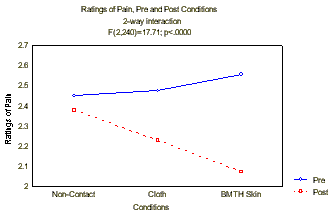“Resurrecting The Reputation Of Touch”
By Paul Bucky, Co-Founder & Executive Director IFBM
Winter 2000
Over a year ago I had the honor of meeting Dr. Gary Schwartz, Director of the Human Energy Systems Laboratory at the University of Arizona, and his wife and collaborator Dr. Linda Russek. This is when we first discussed working together on a Bio-Touch research project.
I told Gary and Linda that we can do all the research we want, but the one thing I wasn’t going to do was jeopardize the opportunity to get this to all the people who want it. Whatever the reason was that people felt they were getting helped, that was good enough for me. Part of me knows that Bio-Touch works – with or without research.
Of course, I realized that there were many people who would feel more comfortable sharing Bio-Touch with the “validation” of research. People always ask, “Is there any research on this?” I also understand that these questions represent to me that other part of my mind that, even after all these years and all my experience with Bio-Touch, seeks an explanation, “proof” that Bio-Touch works.
Since we began, I’ve been a little afraid that all this would “prove” that Bio-Touch actually didn’t work. But I decided that if that happened, I could retire from this public life and go back to living in the mountains. No surprise, though, that the studies show that Bio-Touch is just as effective as we’ve experienced it to be all these years. So we are grateful to Gary for teaching us the “language” of research, for providing the opportunity to satisfy both parts of my mind, but mostly for his generous heart and clear scientific approach that always reminds us to “let the data speak.”
Gary and I co-presented at the Tucson meeting of the Institute of Noetic Sciences on September 1. The complete Power Point is available from jennifer@justtouch.com. The following is a partial transcript of Gary’s research summary, focusing on stress & pain results:
I want to tell you how I came to meet Paul and become involved with this. It’s very curious. I received a phone call from a woman in the Program for Integrative Medicine, Andrew Weil’s program, and she had heard from “this man” who did some kind of “biomagnetic touch healing” and she was interested in possibly bringing this into the Lab. And since we do energy medicine research I suggested that Linda and I meet Paul, and we did. He seemed very serious and very interested in the technique and doing research.
The first thing I was deeply impressed with was the value system of the people who were doing this work. Here they were trying to give away something to everyone that was representing love and caring and that was potentially connecting among families, among age groups, among different economic classes, and so on. To tell you the truth, I fell in love with their value system. I didn’t fall in love with the history [of Bio-Touch]. Because it’s very hard for me to tell my colleagues or anybody else how a mining engineer essentially comes to some sort of inspiration, which may have been spiritual in nature, ends up receiving and developing a system which he then graciously shares with people for which he does not have a license, an MD, or a PhD, or anything like that!
They would keep bringing in mounds of data, so we decided that I would put it into a form that would be ready for publication. I’m now going to take you through this. You’ll be able to get a feeling for the tremendous amount of work the Bio-Touch group has done over the past year. To me it is absolutely breathtaking that a group wants to do research, would put in the energy, and they’re all volunteers. It’s absolutely spectacular.
Thus far, the data are consistent more or less with their hypothesis. That’s a very scientific way of saying, “Really interesting!” We’ve done three experiments thus far. Experiment 1 we call a survey, but it’s really a multi-Centered experiment. Experiment 2 looks at cardiovascular correlates of what takes place during Bio-Touch and also gives cardiovascular measures. Experiment 3 looks at the role of touch with a group of novice undergraduates who had never experienced Bio-Touch before. Our Fourth and Fifth studies are currently in the evolutionary stage.
Experiment 1 – SurveyPre and Post Ratings
- 0 to 10 Rating Scale
- Ratings of Feeling Good, Relaxation, Energy, Stress, and Pain
- Pain Ratings were of Primary, Secondary, and Tertiary Pain
Yes, different people will have different perceptions of the touch. But what you can do is ask people to make ratings about how they’re feeling before the session and then after the session. Now before you say “what about expectancy?” and “what about placebo?” and “what about control group?” – there’s none of that. This is just “what happens in the Center when people come and receive Bio-Touch.” And this is what’s important: the data were collected in four separate locations, so people filled out standardized forms at their Centers in Hawaii, California, Tucson and at Amity, which is a drug and alcohol rehabilitation center in Tucson. There were roughly 600 people.
People in their Centers report that they feel good, feel better, after a session than before. Not bad. That’s probably why people keep coming back!
Decreases in stress; every single Center shows it.
Decreases in Stress replicated over Locations

Decreases in Primary Pain replicated over Locations

Decreases in primary pain; you can see that on average people report a significant decrease in pain. Same pattern for secondary and tertiary pains, and it replicates for both males and females.
In every session the post – is lower than the pre- session. But the interesting thing is you don’t see a decrease [in pain] growing over time. We have to ask why.
Editor’s note: This is a question we’re looking into because it conflicts with recipient reports of decreases in pain over time. Also, there are questions about recipients who use Bio-Touch as a pain management tool for chronic pain situations, and are people reporting the same amount of pain but consequently able to reduce intake of pain medications since starting Bio-Touch, etc.
Experiment 1 – Survey Conclusions
Recipients of Bio-Touch report decreases in restlessness & stress, & increases in energy & relaxation, following Bio-Touch sessions.
- Effects are replicated (1) over 4 locations and (2) sex of the recipient.
- Recipients report decreases in intensity of primary, secondary, and tertiary pains within sessions. The decreases are replicated over sessions, but the decreases do not improve or carry over across sessions.
Experiment 2 – Replication with Cardiovascular Measures Pre, Midway, & Post Ratings of Stress
- Pre & Post Ratings of Restlessness, Cared For, Relaxation, & Primary Pain
- 1 to 5 Ratings Scales
- Systolic & Diastolic Blood Pressure & Heart Rate, recorded Pre & Midway
- Data from Arizona & California
Experiment 2 was partly suggested by a dentist! He suggested it would be nice get some sort of physiological measures to validate these self-reports.
The greater the pain, the greater the decrease that people report. This is replicated in both pain studies. There is a decrease in diastolic but not significant. The effects are mainly in systolic blood pressure.
Decreases in Systolic Pressure

Experiment 2 – Cardiovascular Conclusions Subjective reports replicate & extend findings of Experiment 1 – restlessness, stress & pain decreases, feeling cared for & relaxation increases
- Decreases in cardiovascular responses occur in Bio-Touch
Experiment 3 – Does Touching Matter? University of Arizona students were exposed to Bio-Touch for the first time
- They were taught two sets of points
- They made ratings using 1 – 5 Rating Scales pre and post for three conditions: (1) normal Bio-Touch skin touching, (2) through cloth, and (3) non-contact (e.g. energy).
I invited the Bio-Touch group into one of my classes at the University of Arizona, a class called the Psychology of Love & Spirituality. And since Bio-Touch is an expression of love, though it is not presented in a spiritual context, we decided we would give students an introductory experience in Bio-Touch and also have them participate in research.
We told the students that they would perform the technique under 3 conditions. Condition #1 was to perform Bio-Touch in the traditional way using butterfly touch directly on the skin. The second condition was touch through cloth, same points. The third was “non-contact touch,” just feeling the points a couple of inches above the body. I wanted to give the students the idea that any one of these could have an effect and we didn’t know which of these was better. They worked in pairs, one being the practitioner and one being the recipient and then they would reverse roles.
Here is the really interesting stuff, and if I didn’t see it, I wouldn’t believe it. Decreases in pain by condition; the biggest decrease is with Bio-Touch, there is a minor effect through cloth and virtually nothing with non-contact. Stress; even with non-contact people were reporting a decrease, but Bio-Touch showed the highest. Concerning the question of feeling cared for; the decrease only shows up for touching on skin!
When asked to rank their preferences, the overwhelming preference was for being touched on the skin. By the way, many of the students were saying after the initial introduction that “this touch stuff isn’t going to work,” and when they experienced reductions in pain and stress, they were frankly shocked. Many of them had a transformative experience.
Decreases in Pain by Condition

Increase in Feeling Cared for by Condition
Experiment 3 – Does Touching Matter? Conclusions Novice undergraduate students report decreases in pain, stress, and restlessness, and increases in feeling cared for and relaxation, following Bio-Touch compared to cloth and non-contact control conditions
- Students overwhelming prefer direct skin contact
Implications of the Findings Bio-Touch is associated with positive self-reports (1) in multiple locations, (2) in males & females, and (3) even in novice undergraduate students.
- The more intense the symptoms of pain, the greater the relative decreases in pain reported. However, there is currently no evidence that these effects carry over across sessions.
Needs for Future Research
- Add control groups for expectation, sitting, and specific points selected
- Document possible clinical outcomes that may increase over sessions
- Extend applications to ADHD and other problems in children and families
To me, the idea of Bio-Touch “Resurrecting the Reputation of Touch” is something that, in fact, Bio-Touch is trying to do. One of the things that I’m enthusiastic about is that, typically, when we think of touch it’s either erotic or it’s abuse or it’s the kind of touch when we’re taking something from someone. Touch is hardly ever given like Bio-Touch. I consider this to be extremely important.
Thank you very much.
Gary Schwartz talks more his research into “energy” healing in his book: Energy Healing Experiments

1 Comment